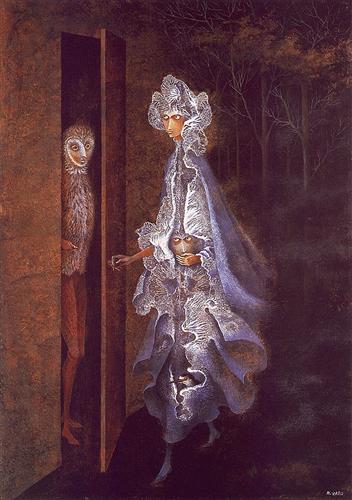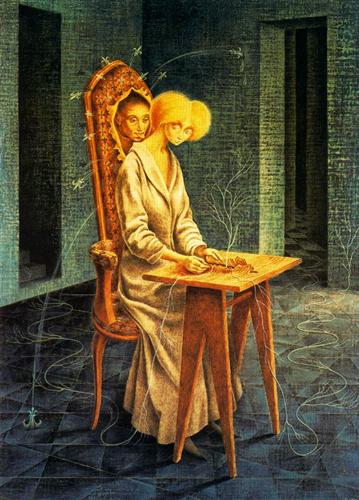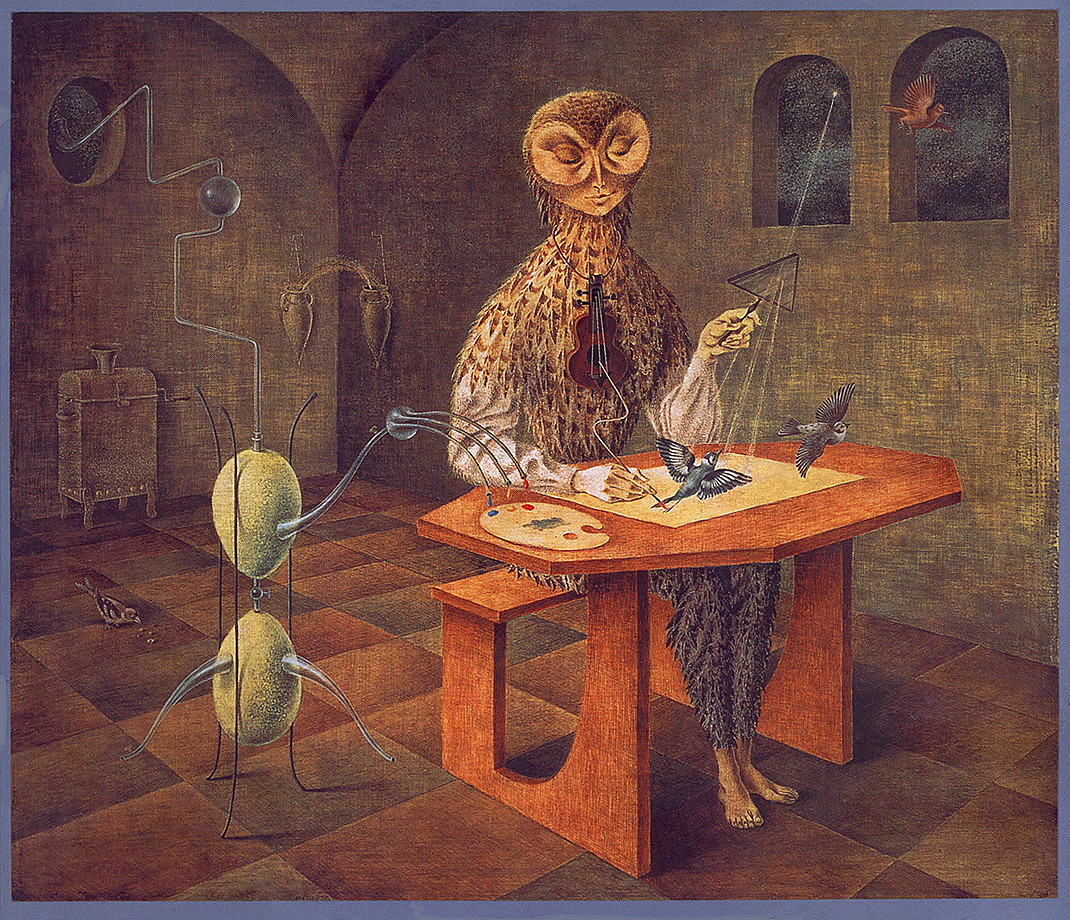Remedios Varo (1908-1963) was a Spanish painter associated with
the French and Mexican Surrealist movements. Varo was classically educated in
painting as a child, before leaving the academy to join the growing Surrealist
movement in Barcelona. Forced to flee Franco Spain and Nazi Germany, Varo
settled in Mexico City in 1940, where she would produce most of her mature
works. Varo’s work features surreal landscapes with mystical and symbolic
imagery, often blurring the lines between living and inanimate forms and
highlighting complex female icons: alchemists, pilgrims, and creators. I was
drawn to Remedios Varo because of the beauty of her paintings, which are
brightly colored and extremely intricate; and because of the bizarre but intuitive symbolism that appears in her artwork.
The Gathering (1960)
Varo worked mostly in small-scale oil paintings, and the
majority of her work was produced during only ten years of her life in
Mexico City. Although her subjects are dreamlike, her painting technique is
very precise and full of small details. She uses extremely bright colors and
exaggerated shading to give an unreal quality to her work; however, her
paintings have an internal logic that makes magical or bizarre subjects seem
reasonable. The overall effect, as for many surrealists, is paintings that
communicate an emotional or spiritual state rather than a concrete reality.
Disturbing Presence (1959)
Varo often painted scenes where female figures interact with
living environments, blurring lines between architectural and organic, living
and inanimate forms. Her characters usually resemble her, and engage
with themes of displacement, travel and spirituality that were important in her own life. In Disturbing Presence (1959), a woman
peels nervelike shapes from a wooden desk as a face emerges from the back of
her chair to lick her neck. This bizarre image shows recurring themes of
inanimate objects developing life; creative production by female scientist/magicians;
and intrusive presences which disrupt or contain the creative energy. While
Varo uses a wide range of surreal icons – human-animal figures, active
and mutating scenery, moonlight, starlight, music and chemistry – her work all
seems to draw on a single symbolic playbook, which is easy to understand
emotionally but very unique to her work.
Creation of the Birds (1959)
Varo renounced Roman Catholicism early in life, but continued to
be fascinated by religion and spirituality; she read extensively on occult
practices as well as psychoanalysis and modern science, and these influences appear
in the symbolism of her work. Many of her paintings have tarot-like occult
imagery mixed with alchemy or magical science. In Creation of the Birds (1957), an owl-like scientist creates
songbirds out of refracted starlight, violin music, and paints distilled from
an alembic. Psychoanalytic theories about the unconscious and collective
archetypes are also visible in her art; although many of her recurring icons
seem to have personal rather than universal meanings, their emotional content
is always clear.
Woman Leaving the Psychoanalyst (1960)
Remedios Varo was involved with the Surrealist movement of the
early 20th century, and her close friends and partners were central
Surrealist figures. However, she avoided the themes I like least about
surrealism: randomness/automatic artwork, and the problematic use of female
symbols. Many male surrealists used the female body in their work in sexualized,
dismembered, or one-dimensional states, representing some aspect of the male
psyche instead of an actual female person. Varo instead presents dreamscapes with feminine or androgynous protagonists who actively control
their surroundings. Rather than being sexual objects or traditional archetypes
of mothers, virgins, etc., Varo’s most common subject is a sort of female
goddess/scientist creating and interacting with a living environment. Her
characters are often in positions of entrapment, discovery or pilgrimage; these
themes are common in feminist literature, but I was surprised to see them
represented visually in such an evocative way.
Works Cited
Janet A. Kaplan. “Remedios Varo.” Feminist Studies. Vol. 13, No. 1. Spring 1987: 38-48. Via JSTOR.
Janet A. Kaplan. “Remedios Varo: Voyages and Visions.” Woman’s Art Journal. Vol. 1, No. 2. Fall
1980: 13-18. Via JSTOR.
Deborah J. Haynes. “The Art of Remedios Varo: Issues of Gender
Ambiguity and Religious Meaning.” Woman’s
Art Journal. Vol. 16, No. 1. Spring 1995: 26-32. Via JSTOR.
All images retrieved from WikiArt.org.




Bailey, I like this artist. She was definitely very talented and full of stories. But I disagree with the feminist interpretation of her works. It's easy to put the label Feminist on a female artist's works, simply because of the fact there are so few of female artists. But each of her works suggests a meaning broader than that, and more diverse than that. Though I haven't fully grasped her symbolization, the spirituality and the psychological narrative stand out to me as an artist's personal journey, encompassing a lot of identity themes rather than representing the collective female voice.
ReplyDeleteThank you for this beautiful post!